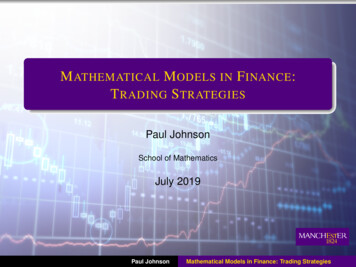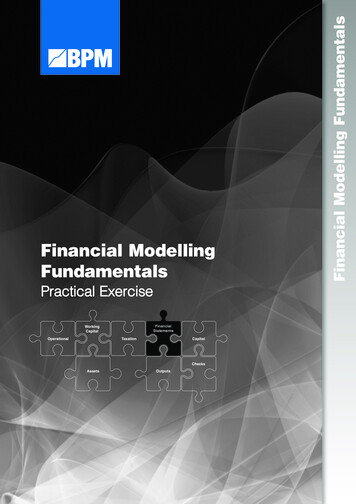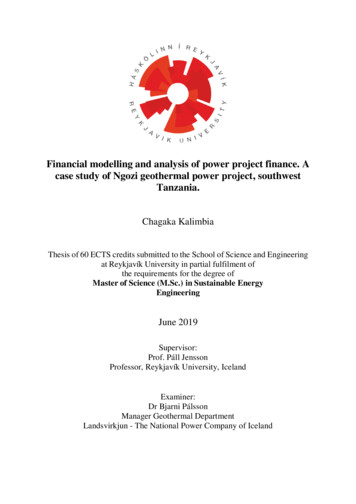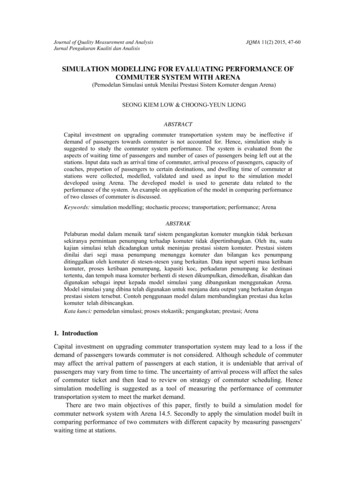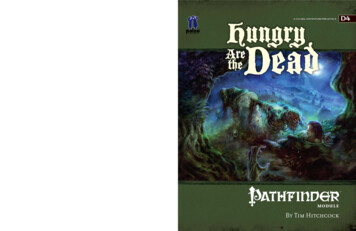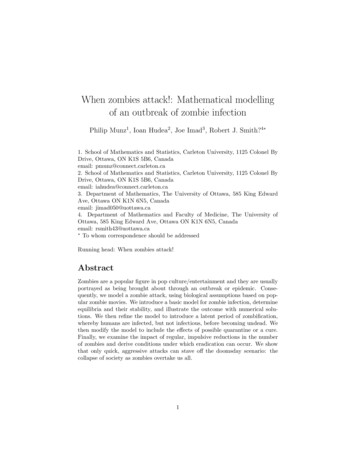
Transcription
When zombies attack!: Mathematical modellingof an outbreak of zombie infectionPhilip Munz1 , Ioan Hudea2 , Joe Imad3 , Robert J. Smith?4 1. School of Mathematics and Statistics, Carleton University, 1125 Colonel ByDrive, Ottawa, ON K1S 5B6, Canadaemail: pmunz@connect.carleton.ca2. School of Mathematics and Statistics, Carleton University, 1125 Colonel ByDrive, Ottawa, ON K1S 5B6, Canadaemail: iahudea@connect.carleton.ca3. Department of Mathematics, The University of Ottawa, 585 King EdwardAve, Ottawa ON K1N 6N5, Canadaemail: jimad050@uottawa.ca4. Department of Mathematics and Faculty of Medicine, The University ofOttawa, 585 King Edward Ave, Ottawa ON K1N 6N5, Canadaemail: rsmith43@uottawa.ca To whom correspondence should be addressedRunning head: When zombies attack!AbstractZombies are a popular figure in pop culture/entertainment and they are usuallyportrayed as being brought about through an outbreak or epidemic. Consequently, we model a zombie attack, using biological assumptions based on popular zombie movies. We introduce a basic model for zombie infection, determineequilibria and their stability, and illustrate the outcome with numerical solutions. We then refine the model to introduce a latent period of zombification,whereby humans are infected, but not infectious, before becoming undead. Wethen modify the model to include the effects of possible quarantine or a cure.Finally, we examine the impact of regular, impulsive reductions in the numberof zombies and derive conditions under which eradication can occur. We showthat only quick, aggressive attacks can stave off the doomsday scenario: thecollapse of society as zombies overtake us all.1
1IntroductionA zombie is a reanimated human corpse that feeds on living human flesh [1].Stories about zombies originated in the Afro-Caribbean spiritual belief systemof Vodou (anglicised voodoo). These stories described people as being controlledby a powerful sorcerer. The walking dead became popular in the modern horrorfiction mainly because of the success of George A. Romero’s 1968 film, Night ofthe Living Dead [2]. There are several possible etymologies of the word zombie.One of the possible origins is jumbie, which comes from the Carribean termfor ghost. Another possible origin is the word nzambi which in Kongo means‘spirit of a dead person’. According to the Merriam-Webster dictionary, theword zombie originates from the word zonbi, used in the Louisiana Creole orthe Haitian Creole. According to the Creole culture, a zonbi represents a personwho died and was then brought to life without speech or free will.The followers of Vodou believe that a dead person can be revived by asorcerer [3]. After being revived, the zombies remain under the control of thesorcerer because they have no will of their own. Zombi is also another namefor a Voodoo snake god. It is said that the sorcerer uses a ‘zombie powder’for the zombification. This powder contains an extremely powerful neurotoxinthat temporarily paralyzes the human nervous system and it creates a stateof hibernation. The main organs, such as the heart and lungs, and all of thebodily functions, operate at minimal levels during this state of hibernation.What turns these human beings into zombies is the lack of oxygen to the brain.As a result of this, they suffer from brain damage.A popular belief in the Middle Ages was that the souls of the dead couldreturn to earth one day and haunt the living [4]. In France, during the MiddleAges, they believed that the dead would usually awaken to avenge some sort ofcrime committed against them during their life. These awakened dead took theform of an emaciated corpse and they wandered around graveyards at night.The idea of the zombie also appears in several other cultures, such as China,Japan, the Pacific, India, Persia, the Arabs and the Americas.Modern zombies (the ones illustrated in books, films and games [1, 5]) arevery different from the voodoo and the folklore zombies. Modern zombies followa standard, as set in the movie Night of the Living Dead [2]. The ghouls areportrayed as being mindless monsters who do not feel pain and who have animmense appetite for human flesh. Their aim is to kill, eat or infect people. The‘undead’ move in small, irregular steps, and show signs of physical decompositionsuch as rotting flesh, discoloured eyes and open wounds. Modern zombies areoften related to an apocalypse, where civilization could collapse due to a plagueof the undead. The background stories behind zombie movies, video games etc,are purposefully vague and inconsistent in explaining how the zombies cameabout in the first place. Some ideas include radiation (Night of the Living Dead[2]), exposure to airborne viruses (Resident Evil [6]), mutated diseases carried byvarious vectors (Dead Rising [7] claimed it was from bee stings from geneticallyaltered bees). Shaun of the Dead [8] made fun of this by not allowing the viewerto determine what actually happened.2
When a susceptible individual is bitten by a zombie, it leaves an open wound.The wound created by the zombie has the zombie’s saliva in and around it. Thisbodily fluid mixes with the blood, thus infecting the (previously susceptible)individual.The zombie that we chose to model was characterised best by the popularculture zombie. The basic assumptions help to form some guidelines as to thespecific type of zombie we seek to model (which will be presented in the nextsection). The model zombie is of the classical pop-culture zombie: slow moving,cannibalistic and undead. There are other ‘types’ of zombies, characterisedby some movies like 28 Days Later [9] and the 2004 remake of Dawn of theDead [10]. These ‘zombies’ can move faster, are more independent and muchsmarter than their classical counterparts. While we are trying to be as broad aspossible in modelling zombies – especially since there are many varieties – wehave decided not to consider these individuals.2The basic modelFor the basic model, we consider three basic classes: Susceptible (S) Zombie (Z) Removed (R)Susceptibles can become deceased through ‘natural’ causes, i.e. non-zombierelated death (parameter δ). The removed class consists of individuals who havedied, either through attack or natural causes. Humans in the removed classcan resurrect and become a zombie (parameter ζ). Susceptibles can becomezombies through transmission via an encounter with a zombie (transmissionparameter β). Only humans can become infected through contact with zombies,and zombies only have a craving for human flesh so we do not consider any otherlifeforms in the model. New zombies can only come from two sources: The resurrected from the newly deceased (removed group) Susceptibles who have ‘lost’ an encounter with a zombieIn addition, we assume the birth rate is a constant, Π. Zombies move to theremoved class upon being ‘defeated’. This can be done by removing the head ordestroying the brain of the zombie (parameter α).We also assume that zombiesdo not attack/defeat other zombies.Thus, the basic model is given byS"Z"R" Π βSZ δS βSZ ζR αSZ δS αSZ ζR .3
Figure 1: The basic modelThis model is illustrated in Figure 1.This model is slightly more complicated than the basic SIR models thatusually characterise infectious diseases [11], because this model has two massaction transmissions, which leads to having more than one nonlinear term inthe model. Mass-action incidence specifies that an average member of the population makes contact sufficient to transmit infection with βN others per unittime, where N is the total population without infection. In this case, the infection is zombification. The probability that a random contact by a zombie ismade with a susceptible is S/N ; thus, the number of new zombies through thistransmission process in unit time per zombie is:(βN )(S/N )Z βSZ .We assume that a susceptible can avoid zombification through an altercationwith a zombie by defeating the zombie during their contact, and each susceptibleis capable of resisting infection (becoming a zombie) at a rate α. So using thesame idea as above with the probability Z/N of random contact of a susceptiblewith a zombie (not the probability of a zombie attacking a susceptible), wehave the number of zombies destroyed through this process per unit time persusceptible is:(αN )(Z/N )S αSZ .The ODEs satisfyS " Z " R" Πand henceS Z R as t , if Π 0. Clearly S , so this results in a ‘doomsday’ scenario:an outbreak of zombies will lead to the collpase of civilisation, as large numbersof people are either zombified or dead.If we assume that the outbreak happens over a short timescale, then we canignore birth and background death rates. Thus, we set Π δ 0.4
Setting the differential equations equal to 0 gives βSZβSZ ζR αSZαSZ ζR 000.From the first equation, we have either S 0 or Z 0. Thus, it follows fromS 0 that we get the ‘doomsday’ equilibrium(S̄, Z̄, R̄) (0, Z̄, 0) .When Z 0, we have the disease-free equilibrium(S̄, Z̄, R̄) (N, 0, 0) .These equilibrium points show that, regardless of their stability, human-zombiecoexistence is impossible.The Jacobian is then βZ βS0J βZ αZ βS αS ζ .αZαS ζThe Jacobian at the disease-free equilibrium is 0 βNJ(N, 0, 0) 0 βN αN0αNWe havedet(J λI) 0ζ . ζ λ{λ2 (ζ (β α)N ]λ βζN } .It follows that the characteristic equation always has a root with positive realpart. Hence, the disease-free equilibrium is always unstable.Next, we have β Z̄0 0J(0, Z̄, 0) β Z̄ αZ̄ 0 ζ .αZ̄0 ζThusdet(J λI) λ(β Z̄ λ)( ζ λ) .Since all eigenvalues of the doomsday equilibrium are negative, it is asymptotically stable. It follows that, in a short outbreak, zombies will likely infecteveryone.In the following figures, the curves show the interaction between susceptiblesand zombies over a period of time. We used Euler’s method to solve the ODE’s.While Euler’s method is not the most stable numerical solution for ODE’s, itis the easiest and least time-consuming. See Figures 2 and 3 for these results.The MATLAB code is given at the end of this chapter. Values used in Figure 3were α 0.005, β 0.0095, ζ 0.0001 and δ 0.0001.5
4;, 7-0?.37!7@!7A7"7B,5C7DEFE7G7HIJ7'!!K2; .15,.;L0-M,.;/012345,0678432.79"!!!:; &!!%!! !!#!!"!!!7!"# %& ,-.'()*"!Figure 2: The case of no zombies. However, this equilibrium is unstable.3The model with latent infectionWe now revise the model to include a latent class of infected individuals. Asdiscussed in Brooks [1], there is a period of time between (approximately 24hours) after the human susceptible gets bitten before they succumb to theirwound and become a zombie.We thus extend the basic model to include the (more ‘realistic’) possibilitythat a susceptible individual becomes infected before succumbing to zombification. This is what is seen quite often in pop-culture representations of zombies([2, 6, 8]).Changes to the basic model include: Susceptibles first move to an infected class once infected and remain therefor some period of time. Infected individuals can still die a ‘natural’ death before becoming a zombie; otherwise, they become a zombie.We shall refer to this as the SIZR model. The model is given byS"I"Z"R" Π βSZ δSβSZ ρI δIρI ζR αSZδS δI αSZ ζRThe SIZR model is illustrated in Figure 46
;27* 5 . ,1!5?!5@5 5A*3B5CD5E5FGH5(!!I07 ,/3*,7J. K*,7-./0123*.456210,758 !!!97:#!!'!!&!!%!! !!!5!!"# "#%%"#)* ,&&"#''"##Figure 3: Basic model outbreak scenario. Susceptibles are quickly eradicatedand zombies take over, infecting everyone.Figure 4: The SIZR model: the basic model with latent infectionAs before, if Π 0, then the infection overwhelms the population. Consequently, we shall again assume a short timescale and hence Π δ 0. Thus,when we set the above equations to 0, we get either S 0 or Z 0 from thefirst equation. This follows again from our basic model analysis that we get theequilibria:Z 0S 0 Z̄, R̄) (N, 0, 0, 0)(S̄, I, Z̄, R̄) (0, 0, Z̄, 0)(S̄, I,Thus, coexistence between humans and zombies/infected is again not possible.7
In this case, the Jacobian is JFirst, we havedet(J(N, 0, 0, 0) λI) βZ βZ αZαZ λ 0det 00 λ det 00 .ζ ζ0 βS ρ βSρ αS0αS0 ρ λρ0 ρ λρ0 βNβN αN λαNβN αN λαN 0 0 ζ ζ λ 0 ζ ζ λ' λ λ3 (2ρ αN )λ2 (ραN ρ2 ρβN )λ( ρ2 βN .Since ρ2 βN 0, it follows that det(J(N, 0, 0, 0) λI) has an eigenvalue withpositive real part. Hence, the disease-free equilibrium is unstable.Next, we have β Z̄ λ000 β Z̄ ρ λ 00 .det(J(0, 0, Z̄, 0) λI) det αZ̄ ρ λζαZ̄00 ζ λThe eigenvalues are thus λ 0, β Z̄, ρ, ζ. Since all eigenvalues are nonpositive, it follows that the doomsday equilibrium is stable. Thus, even with alatent period of infection, zombies will again take over the population.We plotted numerical results from the data again using Euler’s method forsolving the ODEs in the model. The parameters are the same as in the basicmodel, with ρ 0.005. See Figure 5. In this case, zombies still take over, butit takes approximately twice as long.4The model with quarantineIn order to contain the outbreak, we decided to model the effects of partialquarantine of zombies. In this model, we assume that quarantined individualsare removed from the population and cannot infect new individuals while theyremain quarantined. Thus, the changes to the previous model include: The quarantined area only contains members of the infected or zombiepopulations (entering at rates κ and σ, rspectively).8
; 5?.@,1!5 !5A5&5B*3C5 D5E5FGH872 ,5I210,75J.K5/2K2 ,3,K7507,@5*45/K,I*.075J*L0K,:5'!!;07M,/3*,7 . !&!!'!!5!"# %&!)* ,Figure 5: An outbreak with latent infection. There is a chance some members will try to escape, but any that tried towould be killed before finding their ‘freedom’ (parameter γ). These killed individuals enter the removed class and may later becomereanimated as ‘free’ zombies.The model equations are:S"I"Z"R"Q" Π βSZ δSβSZ ρI δI κIρI ζR αSZ σZδS δI αSZ ζR γQκI σZ γQ .The model is illustrated in Figure 6.For a short outbreak (Π δ 0), we have two equilibria, Z̄, R̄, Q̄) (N, 0, 0, 0, 0), (0, 0, Z̄, R̄, Q̄) .(S̄, I,In this case, in order to analyse stability, we determined the basic reproductiveratio, R0 [12] using the next-generation method [13]. The basic reproductiveratio has the property that if R0 1 then the outbreak will persist, whereas ifR0 1, then the outbreak will be eradicated.If we were to determine the Jacobian and evaluate it at the disease-freeequilibrium, we would have to evaluate a nontrivial 5 by 5 system and a characteristic polynomial of degree of at least 3. With the next-generation method,9
Figure 6: Model Equations for the Quarantine modelwe only need to consider the infective differential equations I " , Z " and Q" . Here,F is the matrix of new infections and V is the matrix of transfers betweencompartments. 0 βN 0ρ κ0000 , V ραN σ 0 F 0000 κ σγ 1 F V 1 V γ(αN σ)001 ργγ(ρ κ)0γ(ρ κ)(αN σ)ρσ κ(αN σ) σ(ρ κ) (ρ κ)(αN σ) βN ργ βN γ(ρ κ) 01 000 .γ(ρ κ)(αN σ)000This gives usR0 βN ρ.(ρ κ)(αN σ)It follows that the disease-free equilibrium is only stable if R0 1. Thiscan be achieved by increasing κ or σ, the rates of quarantining infected andzombified individuals, respectively. If the population is large, thenR0 βρ.(ρ κ)αIf β α (zombies infect humans faster than humans can kill them, which weexpect), then eradication depends critically on quarantining those in the primarystages of infection. This may be particularly difficult to do, if identifying suchindividuals is not obvious [8].10
However, we expect that quarantining a large percentage of infected individuals is unrealistic, due to infrastructure limitations. Thus, we do not expectlarge values of κ or σ, in practice. Consequently, we expect R0 1.As before, we illustrate using Euler’s method. The parameters were thesame as those used in the previous models. We varied κ, σ, γ to satisfy R0 1.The results are illustrated in Figure 7. In this case, the effect of quarantine isto slightly delay the time to eradication of humans. ?@A7B0C.3!7@!7D7"7E,5F7 97M,O2N. 7&!!%&!/012345,0678432.97:"!!!;9 %!! &! !! 29P.15,.9?0-Q,.9#&!#!!"&!"!!&!!7!"# %& ,-.'()*"!Figure 7: An outbreak with quarantine.The fact that those individuals in Q were destroyed made little differenceoverall to the analysis as our intervention (i.e. destroying the zombies) did nothave a major impact to the system (we were not using Q to eradicate zombies).It should also be noted that we still expect only two outcomes: either zombiesare eradicated, or they take over completely.Notice that, in Figure 7 at t 10 there are fewer zombies than in the Figure5 at t 10. This is explained by the fact that the numerics assume that theQuarantine class continues to exist, and there must still be zombies in thatclass. The zombies measured by the curve in the figure are considered the ‘free’zombies - the ones in the Z class and not in Q.5A model with treatmentSuppose we are able to quickly produce a cure for ‘zombie-ism’. Our treatmentwould be able to allow the zombie individual to return to their human formagain. Once human, however, the new human would again be susceptible tobecoming a zombie; thus, our cure does not provide immunity. Those zombies11
who resurrected from the dead and who were given the cure were also able toreturn to life and live again as they did before entering the R class.Things that need to be considered now include: Since we have treatment, we no longer need the quarantine. The cure will allow zombies to return to their original human form regardless of how they became zombies in the first place. Any cured zombies become susceptible again; the cure does not provideimmunity.Thus, the model with treatment is given byS"I"Z"R" Π βSZ δS cZβSZ ρI δIρI ζR αSZ cZδS δI αSZ ζR .The model is illustrated in Figure 8.Figure 8: Model equations for the SIZR model with cureAs in all other models, if Π 0, then S I Z R , so we setΠ δ 0. When Z 0, we get our usual disease-free equilibrium, Z̄, R̄) (N, 0, 0, 0) .(S̄, I,However, because of the cZ term in the first equation, we now have the possi Z̄, R̄) satisfyingbility of an endemic equilibrium (S̄, I, β S̄ Z̄ cZ̄β S̄ Z̄ ρI ρI ζ R̄ αS̄ Z̄ cZ̄αS̄ Z̄ ζ R̄12 0000.
Thus, the equilibrium is Z̄, R̄)(S̄, I,The Jacobian isJWe thus have βZ βZ αZαZ Z̄, R̄) λI)det(J(S̄, I, )c cαc, Z̄,Z̄β ρ ρβ*. 0 βS c 0 ρβS0 .ρ αS c ζ 0αS ζ β Z̄ β Z̄det αZ̄αZ̄ 00 αc cζβαc ζβ0 ρρ0 0c ρc0αc (β Z̄ λ) det ρ β c ζ αc0 ζβ ,)*αc2 (β Z̄ λ) λ λ ρ c ζ λβ-.ραc ρζ cζ.βSinze the quadratic expression has only positive coefficients, it follows that thereare no positive eigenvalues. Hence, the coexistence equilibrium is stable.The results are illustrated in Figure 9. In this case, humans are not eradicated, but only exist in low numbers.6Impulsive EradicationFinally, we attempted to control the zombie population by strategically destroying them at such times that our resources permit (as suggested in [14]). It wasassumed that it would be difficult to have the resources and coordination, sowe would need to attack more than once, and with each attack try and destroymore zombies. This results in an impulsive effect [15, 16, 17, 18].Here, we returned to the basic model and added the impulsive criteria:S"Z"R" Z Π βSZ δS βSZ ζR αSZ δS αSZ ζR knZtttt tn tn tn tn ,where k (0, 1] is the kill ratio and n denotes the number of attacks requireduntil kn 1. The results are illustrated in Figure 10.13
; 5?*3@5A0B,5!5 !5C5&5?*3@5 A5D5EFG872 ,5H210,75I.B5/2B2 ,3,B7507,J5*45/B,H*.075I*K0B,:5'!!;07L,/3*,7 . !&!!'!!5!"# %&!)* ,Figure 9: The model with treatment, using the same parameter values as thebasic modelIn Figure 10, we used k 0.25 and the values of the remaining parameterswere (α, β, ζ, δ) (0.0075, 0.0055, 0.09, 0.0001). Thus, after 2.5 days, 25% ofzombies are destroyed; after 5 days, 50% of zombies are destroyed; after 7.5days, 75% of remaining zombies are destroyed; after 10 days, 100% of zombiesare destroyed.7DiscussionAn outbreak of zombies infecting humans is likely to be disastrous, unless extremely aggressive tactics are employed against the undead. While aggressivequarantine may eradicate the infection, this is unlikely to happen in practice. Acure would only result in some humans surviving the outbreak, although theywill still coexist with zombies. Only ever-increasing attacks, with increasingforce, will result in eradication, assuming the available resources can be mustered in time.Furthermore, these results assumed that the timescale of the outbreak wasshort, so that the natural birth and death rates could be ignored. If the timescaleof the outbreak increases, then the result is the doomsday scenario: an outbreakof zombies will result in the collapse of civilisation, with every human infected,or dead. This is because human births and deaths will provide the undeadwith a limitless supply of new bodies to infect, resurrect and convert. Thus,if zombies arrive, we must act quickly and decisively to eradicate them beforethey eradicate us.The key difference between the models presented here and other models14
Eradication with increasing kill ratios1000900800Number of Zombies70060050040030020010000246810TimeFigure 10: Zombie eradication using impulsive atttacks.of infectious disease is that the dead can come back to life. Clearly, this is anunlikely scenario if taken literally, but possible real-life applications may includealllegiance to political parties, or diseases with a dormant infection.This is, perhaps unsurprisingly, the first mathematical analysis of an outbreak of zombie infection. While the scenarios considered are obviously notrealistic, it is nevertheless instructive to develop mathematical models for anunusual outbreak. This demonstrates the flexibility of mathematical modellingand shows how modelling can respond to a wide variety of challenges in ‘biology’.In summary, a zombie outbreak is likely to lead to the collapse of civilisation,unless it is dealt with quickly. While aggressive quarantine may contain theepidemic, or a cure may lead to coexistence of humans and zombies, the mosteffective way to contain the rise of the undead is to hit hard and hit often. Asseen in the movies, it is imperative that zombies are dealt with quickly, or elsewe are all in a great deal of trouble.AcknowledgementsWe thank Shoshana Magnet, Andy Foster and Shannon Sullivan for useful discussions. RJS? is supported by an NSERC Discovery grant, an Ontario EarlyResearcher Award and funding from MITACS.15
References[1] Brooks, Max, 2003 The Zombie Survival Guide - Complete Protection fromthe Living Dead, Three Rivers Press, pp. 2-23.[2] Romero, George A. (writer, director), 1968 Night of the Living Dead.[3] Davis, Wade, 1988 Passage of Darkness - The Ethnobiology of the HaitianZombie, Simon and Schuster pp. 14, 60-62.[4] Davis, Wade, 1985 The Serpent and the Rainbow, Simon and Schuster pp.17-20, 24, 32.[5] Williams, Tony, 2003 Knight of the Living Dead - The Cinema of GeorgeA. Romero, Wallflower Press pp.12-14.[6] Capcom, Shinji Mikami (creator), 1996-2007 Resident Evil.[7] Capcom, Keiji Inafune (creator), 2006 Dead Rising.[8] Pegg, Simon (writer, creator, actor), 2002 Shaun of the Dead.[9] Boyle, Danny (director), 2003 28 Days Later.[10] Snyder, Zack (director), 2004 Dawn of the Dead.[11] Brauer, F. Compartmental Models in Epidemiology. In: Brauer, F., van denDriessche, P., Wu, J. (eds). Mathematical Epidemiology. Springer Berlin2008.[12] Heffernan, J.M., Smith, R.J., Wahl, L.M. (2005). Perspectives on the BasicReproductive Ratio. J R Soc Interface 2(4), 281-293.[13] van den Driessche, P., Watmough, J. (2002) Reproduction numbers andsub-threshold endemic equilibria for compartmental models of diseasetransmission. Math. Biosci. 180, 29-48.[14] Brooks, Max, 2006 World War Z - An Oral History of the Zombie War,Three Rivers Press.[15] Bainov, D.D. & Simeonov, P.S. Systems with Impulsive Effect. Ellis Horwood Ltd, Chichester (1989).[16] Bainov, D.D. & Simeonov, P.S. Impulsive differential equations: periodicsolutions and applications. Longman Scientific and Technical, Burnt Mill(1993).[17] Bainov, D.D. & Simeonov, P.S. Impulsive Differential Equations: Asymptotic Properties of the Solutions. World Scientific, Singapore (1995).[18] Lakshmikantham, V., Bainov, D.D. & Simeonov, P.S. Theory of ImpulsiveDifferential Equations. World Scientific, Singapore (1989).16
function [ ] zombies(a,b,ze,d,T,dt)% This function will solve the system of ODE’s for the basic model used in% the Zombie Dynamics project for MAT 5187. It will then plot the curve of% the zombie population based on time.% Function Inputs: a - alpha value in model: "zombie destruction" rate%b - beta value in model: "new zombie" rate%ze - zeta value in model: zombie resurrection rate%d - delta value in model: background death rate%T - Stopping time%dt - time step for numerical solutions% Created by Philip Munz, November 12, 2008%Initial set up of solution vectors and an initial conditionN 500;%N is the populationn T/dt;t zeros(1,n 1);s zeros(1,n 1);z zeros(1,n 1);r zeros(1,n 1);s(1) N;z(1) 0;r(1) 0;t 0:dt:T;% Define the ODE’s of the model and solve numerically by Euler’s method:for i 1:ns(i 1) s(i) dt*(-b*s(i)*z(i)); %here we assume birth rate background deathrate, sz(i 1) z(i) dt*(b*s(i)*z(i) -a*s(i)*z(i) ze*r(i));r(i 1) r(i) dt*(a*s(i)*z(i) d*s(i) - ze*r(i));if s(i) 0 s(i) Nbreakendif z(i) N z(i) 0breakendif r(i) 0 r(i) Nbreakendendhold scepties’,’Zombies’)-----------17
function [z] eradode(a,b,ze,d,Ti,dt,s1,z1,r1)% This function will take as inputs, the initial value of the 3 classes.% It will then apply Eulers method to the problem and churn out a vector of% solutions over a predetermined period of time (the other input).% Function Inputs: s1, z1, r1 - initial value of each ODE, either the%actual initial value or the value after the%impulse.%Ti - Amount of time between inpulses and dt is time step% Created by Philip Munz, November 21, 2008k Ti/dt;%s zeros(1,n 1);%z zeros(1,n 1);%r zeros(1,n 1);%t 0:dt:Ti;s(1) s1;z(1) z1;r(1) r1;for i 1:ks(i 1) s(i) dt*(-b*s(i)*z(i)); %here we assume birth rate background deathrate, sz(i 1) z(i) dt*(b*s(i)*z(i) -a*s(i)*z(i) ze*r(i));r(i 1) r(i) dt*(a*s(i)*z(i) d*s(i) - ze*r(i));end%plot(t,z)-----------function [] erad(a,b,ze,d,k,T,dt)% This is the main function in our numerical impulse analysis, used in% conjunction with eradode.m, which will simulate the eradication of% zombies. The impulses represent a coordinated attack against zombiekind% at specified times.% Function Inputs: a - alpha value in model: "zombie destruction" rate%b - beta value in model: "new zombie" rate%ze - zeta value in model: zombie resurrection rate%d - delta value in model: background death rate%k - "kill" rate, used in the impulse%T - Stopping time%dt - time step for numerical solutions% Created by Philip Munz, November 21, 2008N 1000;Ti T/4; %We plan to break the solution into 4 parts with 4 impulsesn Ti/dt;18
m T/dt;s zeros(1,n 1);z zeros(1,n 1);r zeros(1,n 1);sol zeros(1,m 1); %The solution vector for all zombie impulses and sucht zeros(1,m 1);s1 N;z1 0;r1 0;%i 0;%i is the intensity factor for the current impulse%for j 1:n:T/dt%i i 1;%t(j:j n) Ti*(i-1):dt:i*Ti;%sol(j:j n) eradode(a,b,ze,d,Ti,dt,s1,z1,r1);%sol(j n) sol(j n)-i*k*sol(j n);%s1 N-sol(j n);%z1 sol(j n 1);%r1 0;%endsol1 eradode(a,b,ze,d,Ti,dt,s1,z1,r1);sol1(n 1) sol1(n 1)-1*k*sol1(n 1);%347.7975;s1 N-sol1(n 1);z1 sol1(n 1);r1 0;sol2 eradode(a,b,ze,d,Ti,dt,s1,z1,r1);sol2(n 1) sol2(n 1)-2*k*sol2(n 1);s1 N-sol2(n 1);z1 sol2(n 1);r1 0;sol3 eradode(a,b,ze,d,Ti,dt,s1,z1,r1);sol3(n 1) sol3(n 1)-3*k*sol3(n 1);s1 N-sol3(n 1);z1 sol3(n 1);r1 0;sol4 eradode(a,b,ze,d,Ti,dt,s1,z1,r1);sol4(n 1) sol4(n 1)-4*k*sol4(n 1);s1 N-sol4(n 1);z1 sol4(n 1);r1 0;sol [sol1(1:n),sol2(1:n),sol3(1:n),sol4];t 0:dt:T;t1 0:dt:Ti;t2 Ti:dt:2*Ti;t3 2*Ti:dt:3*Ti;t4 3*Ti:dt:4*Ti;19
%plot(t,sol)hold t4,sol4,’k’)hold off20
by a powerful sorcerer. The walking dead became popular in the modern horror fiction mainly because of the success of George A. Romero’s 1968 film, Night of the Living Dead [2]. There are several possible etymologies of the word zombie. One of the possible origins




